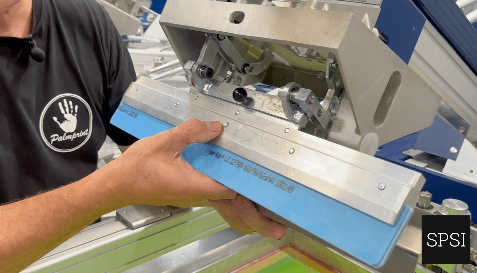In Service for over 45+ yrs

The question often asked:
First of all, what are triple blades?
A very simple equation would be:
The hardness of a blade is hard to judge if we press down on the flat surface with a finger, we are trying to assign a number which correlates to the indentation our finger makes.
I advise a different approach which although is not as accurate as a digital probe device, will give a great visual indication of the shore we are using.
Here is where I must make a huge disclaimer, and before all the people who actually studied at school start sliding into my DM’s to try and take away my hard earned guru status! ( sarcasm). The true measurement of shore is to measure the indentation using a highly calibrated digital device.
We are printers, we measure everything in fingers!
So please bear with me with my shop floor measurement! Imagine the force required to bend that highly sophisticated measuring digit (finger) and assign a number to it.
When I started printing, we had three basic choices,
Life was simple, the color of the blade denoted the hardness and there were only three choices. (We will skip the edge definition for now! I don’t have the time to cover why we would use a half round blade).
There were occasions when we would need something between a 65 and a 75 shore blade, the only issue was that a step of only 5 shore didn’t quite cut it! We wanted the edge of a 65 with the stiffness of a 90.
The introduction of stiffening devices was trialled but in all honesty, they were impractical to use and clean!
The blades with metal fingers along the edge not facing the ink did a great job of not allowing the rubber to bend but were impossible to clean.
The blades with an extended holder on one side would also reduce the bend of the blade, but they could only be used one way round.
The composite or triple blade was born.
By making a sandwich of Red 65 rubber, White 90 rubber and red 65 rubber we have created the perfect solution.
The part of the blade that touches the ink and forces the ink through the mesh is still soft enough to deliver good opacity, but its bend is reduced by the stiffener sandwiched in the middle, ensuring we keep detail also.
The pattern is repeated with a 75-shore sandwiched onto a 90 stiffener, this gives us detail and a super sharp print.
I love the fact we have the option of a composite blade now, but it does make teaching a little more confusing.
Now we have more options:
This little table would be a perfect thing to bookmark and save, but the true forces of business have distorted the simplicity (Surprise!!)
Manufacturers are constantly trying to save money and will offer you whatever shore you want, in any color they have left over from making skateboard wheels!!
And this has led to the introduction of a myriad of colors often being the same Shore hardness! It has also introduced halfway points!
At the time of writing these are the blades we can currently buy and the color has no reference to the Shore value!
|
55 |
55/90/55 |
60 |
60/90/60 |
65 |
65/90/65 |
70 |
70/90/70 |
75 |
75/90/75 |
85 |
Soft <--------------------------------to-----------------------------------------> Hard
Now we know the effect of a hard or soft blade we can answer the original question, an underbase would typically require opacity (Soft Blade) and detail (Hard Blade) so a 65/90/65 would be a perfect starting point.
Top colors would traditionally require less ink and more detail, here a 75/9075 would be a great place to start.
There are no rules in screen printing! It all depends on the will of the Screen Gods, a small amount of witchcraft is always present. We can control as many variables as we can, but sometimes we must “Mess around and find out”.
Article written by Tony Palmer, Palmprint
Tony has more than 30 years experience in garment decoration ranging from manual screen printing on hand carousels to the operation of multi-color automatic presses. Specifically Tony is an expert on MHM Automatics, Tesoma, Exile Spyder, Douthitt CTS, Zentner, and numerous manufacturers of textile decorating equipment.